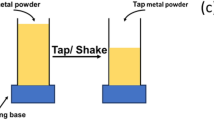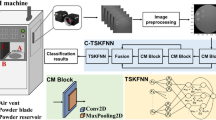Abstract
Plasma arc additive manufacturing (PAM) is an additive manufacturing technology that has been widely used in the past and has practical applications in many fields. The non-destructive testing methodology of PAM workpiece quality monitoring requires high level of accuracy and real-time capability. The characteristics of the melt pool and plasma arc are the keys to characterizing the dynamic manufacturing process during the powder feed PAM process, allowing for process prediction and real-time feedback control. This paper describes a new image recognition system that uses a fully convolutional network (FCN) to acquire melt pool and plasma arc morphologies simultaneously. Its image segmentation performance is compared with four conventional methods and three artificial intelligence methods. Results show that the FCN method can extract melt pool and plasma arc quickly and accurately, even in a complex manufacturing environment. The image segmentation-based FCN’s accuracy is 95.1%, and the average processing time is only 84 ms, according to the results. The performance is far superior to the existing seven methods. The relationship between average captured areas (melt pool and plasma arc) and parameters of the plasma arc (current intensity and scanning speed) is then analyzed. Finally, the quality of products in terms of sample surface roughness is measured, and its relationship with the average areas of the melt pool and plasma arc is clarified.











Similar content being viewed by others
Availability of data and material
Not applicable.
Code availability
Not applicable.
References
Juechter V, Franke MM, Merenda T, Stich A, Körner C, Singer RF (2018) Additive manufacturing of Ti-45Al-4Nb-C by selective electron beam melting for automotive applications. Addit Manuf 22:118–126
Jiang J, Lou J, Hu G (2019) Effect of support on printed properties in fused deposition modelling processes. Virtual Phys Prototy 14:308–315
King WE, Anderson AT, Ferencz RM, Hodge NE, Kamath C, Khairallah SA, Rubencik AM (2015) Laser powder bed fusion additive manufacturing of metals; physics, computational, and materials challenges. Appl Phys Rev 2:041304
Edwards P, O’Conner A, Ramulu M (2013) Electron beam additive manufacturing of titanium components: properties and performance. J Manuf Sci E-T Asme 135:61016–61011
Bimber BA, Hamilton RF, Keist J, Palmer TA (2016) Anisotropic microstructure and superelasticity of additive manufactured NiTi alloy bulk builds using laser directed energy deposition. Mater Sci Eng A 674:125–134
Lin J, Lv Y, Liu Y, Sun Z, Wang K, Li Z, Wu Y, Xu B (2017) Microstructural evolution and mechanical property of Ti-6Al-4V wall deposited by continuous plasma arc additive manufacturing without post heat treatment. J Mech Behav Biomed Mater 69:19–29
Szost BA, Terzi S, Martina F, Boisselier D, Prytuliak A, Pirling T, Hofmann M, Jarvis DJ (2016) A comparative study of additive manufacturing techniques: residual stress and microstructural analysis of CLAD and WAAM printed Ti-6Al-4V components. Mater Design 89:559–567
Bauereiß A, Scharowsky T, Körner C (2014) Defect generation and propagation mechanism during additive manufacturing by selective beam melting. J Mater Process Tech 214:2522–2528
Khairallah SA, Anderson AT, Rubenchik A, King WE (2016) Laser powder-bed fusion additive manufacturing: physics of complex melt flow and formation mechanisms of pores, spatter, and denudation zones. Acta Mater 108:36–45
Charalampous P, Kostavelis I, Kopsacheilis C, Tzovaras D (2021) Vision-based real-time monitoring of extrusion additive manufacturing processes for automatic manufacturing error detection. Int J Adv Manuf Technol 115:3859–3872
He W, Shi W, Li J, Xie H (2019) In-situ monitoring and deformation characterization by optical techniques; part I: Laser-aided direct metal deposition for additive manufacturing. Opt Laser Eng 122:74–88
Barua S, Liou F, Newkirk J, Sparks T (2014) Vision-based defect detection in laser metal deposition process. Rapid Prototyping J 20:77–86
Clijsters S, Craeghs T, Buls S, Kempen K, Kruth JP (2014) In situ quality control of the selective laser melting process using a high-speed, real-time melt pool monitoring system. Int J Adv Manuf Technol 75:1089–1101
Zhang Y, Fuh JYH, Ye D, Hong GS (2019) In-situ monitoring of laser-based PBF via off-axis vision and image processing approaches. Addit Manuf 25:263–274
Zhan Q, Liang Y, Ding J, Williams S (2017) A wire deflection detection method based on image processing in wire+arc additive manufacturing. Int J Adv Manuf Technol 89:755–763
Gobert C, Reutzel EW, Petrich J, Nassar AR, Phoha S (2018) Application of supervised machine learning for defect detection during metallic powder bed fusion additive manufacturing using high resolution imaging. Addit Manuf 21:517–528
Repossini G, Laguzza V, Grasso M, Colosimo BM (2017) On the use of spatter signature for in-situ monitoring of laser powder bed fusion. Addit Manuf 16:35–48
Grasso M, Demir AG, Previtali B, Colosimo BM (2018) In situ monitoring of selective laser melting of zinc powder via infrared imaging of the process plume. Robot Cim-Int Manuf 49:229–239
Khanzadeh M, Bian L, Shamsaei N, Thompson SM (2016) Porosity detection of laser based additive manufacturing using melt pool morphology clustering. In solid freeform fabrication: proceedings of the 27th Annual International Solid Fabrication Symposium—An Additive Manufacturing Conference 1487–1494
Khanzadeh M, Chowdhury S, Tschopp MA, Doude HR, Marufuzzaman M, Bian L (2019) In-situ monitoring of melt pool images for porosity prediction in directed energy deposition processes. IISE Trans 51:437–455
Yang D, Li H, Liu S, Song C, Yang Y, Shen S, Lu J, Liu Z, Zhu Y (2020) In situ capture of spatter signature of SLM process using maximum entropy double threshold image processing method based on genetic algorithm. Opt Laser Technol 131:106371
Fang Q, Tan Z, Li H, Song C, Zhou X, Yang Y, Shen S (2021) Neural network based image segmentation for spatter extraction during selective laser melting processing. J Manuf Process 68:347–355
Tan Z, Fang Q, Li H, Liu S, Zhu W, Yang D (2020) Neural network based image segmentation for spatter extraction during laser-based powder bed fusion processing. Opt Laser Technol 130:106347
Haralick RM, Shapiro LG (1985) Image segmentation techniques. Computer Vision, Graphics, and Image Processing 29:100–132
Marr D, Hildreth E (1980) Theory of edge detection. Proc R Soc Lond 207:187–217
Lin D, Dai J, He K, Sun J (2016) Scribblesup: Scribble-supervised convolutional networks for semantic segmentation. In Proceedings of the IEEE Conference on Computer Vision and Pattern Recognition 3159–3167
Long J, Shelhamer E, Darrell T (2015) Fully convolutional networks for semantic segmentation. In IEEE Conference on Computer Vision and Pattern Recognition (CVPR) 3431–3440
Guo J, Li Y, Lin W, Chen Y, Li J (2018) Network decoupling: From regular to depthwise separable convolutions. In British Machine Vision Conference
Zhang M, Yuan H (1997) The PauTa criterion and rejecting the bnormal value. J Zhengzhou Univ Technol 1:84–88
Funding
This work was supported by the Key-Area Research and Development Program of Guangdong Province, China (2018B090905001); the Key Research and Development Program of Sichuan Province, China (2020YFSY0054); and the Key Research and Development Program of Hubei province, China (2020BAB045).
Author information
Authors and Affiliations
Contributions
Yikai Zhang: Conceptualization, Methodology, Formal analysis. Jiqian Mi: Data Curation, Visualization. Hui Li: Writing-Review and Editing, Supervision. Shengnan Shen: Writing-Review and Editing. Yongqiang Yang: Writing-Review and Editing, Supervision. Changhui Song: Writing-Review and Editing. Xin Zhou: Writing-Review and Editing.
Corresponding authors
Ethics declarations
Ethics approval
The authors confirm that the submitted work is original and has not been published elsewhere.
Consent to participate
All authors have agreed to participate in this work.
Consent for publication
All authors have informed and agreed to publish this work.
Conflict of interest
The authors declare no competing interests.
Additional information
Publisher's Note
Springer Nature remains neutral with regard to jurisdictional claims in published maps and institutional affiliations.
Rights and permissions
About this article
Cite this article
Zhang, Y., Mi, J., Li, H. et al. In situ monitoring plasma arc additive manufacturing process with a fully convolutional network. Int J Adv Manuf Technol 120, 2247–2257 (2022). https://doi.org/10.1007/s00170-022-08929-3
Received:
Accepted:
Published:
Issue Date:
DOI: https://doi.org/10.1007/s00170-022-08929-3




